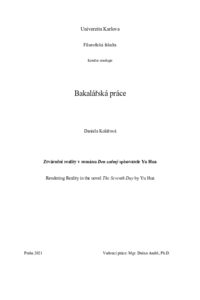Ztvárnění reality v románu Den sedmý spisovatele Yu Hua
Rendering Reality in the novel The Seventh Day by Yu Hua
bakalářská práce (OBHÁJENO)

Zobrazit/
Trvalý odkaz
http://hdl.handle.net/20.500.11956/136528Identifikátory
SIS: 221530
Kolekce
- Kvalifikační práce [24991]
Autor
Vedoucí práce
Oponent práce
Lomová, Olga
Fakulta / součást
Filozofická fakulta
Obor
Sinologie
Katedra / ústav / klinika
Katedra sinologie
Datum obhajoby
24. 6. 2021
Nakladatel
Univerzita Karlova, Filozofická fakultaJazyk
Čeština
Známka
Výborně
Klíčová slova (česky)
čínská literatura|Yu Hua|Den sedmý|Di qi tianKlíčová slova (anglicky)
Chinese literature|Yu Hua|The Seventh Day|Di qi tianPráce podrobuje analýze román Den sedmý (2013) od současného čínského spisovatele Yu Hua (* 1960), který nápaditým způsobem zrcadlí dění v soudobé čínské společnosti a upozorňuje na mnohé problémy dnešní Číny. Yu Hua v románu využívá ozvláštňující způsob vyprávění: vypravěčem a hlavním protagonistou příběhu je Yang Fei, který po své smrti po dobu sedmi dnů putuje Zemí nepohřbených. Ačkoliv autor využívá některé experimentální postupy ztvárňování reality, román vykazuje zároveň řadu podobností s tradičními čínskými romány z pozdního období vlády dynastie Qing. Dílo je zasazeno do kontextu spisovatelovy románové tvorby, zevrubná analýza románu Den sedmý se zaměřuje na specifické postupy ztvárnění reality a na další významotvorné složky, které rozhodující měrou určují povahu literárního obrazu soudobé Číny, jako jsou například náboženské motivy, prvky nadpřirozena či groteskna a frašky. .
This bachelor thesis focuses on the novel The Seventh Day (2013) written by contemporary Chinese author Yu Hua (* 1960). The novel imaginatively reflects the situation in contemporary Chinese society and draws attention to many problems of today's China. In the novel Yu Hua uses an innovative way of narration: the narrator and the main protagonist of the story is Yang Fei, who after his death travels around the Land of the Unburied for seven days. Although the author uses some experimental techniques to depict reality, the novel also shows several similarities with traditional Chinese novels of the late Qing dynasty. The novel is thoroughly analysed and introduced in literary historical context. Focus of the analysis is on rendering reality of this novel and on other meaning-making elements, which decisively determine the nature of the literary image of contemporary China, such as the religious motifs of the work, the use of supernatural elements or the motifs of grotesque and farce.
